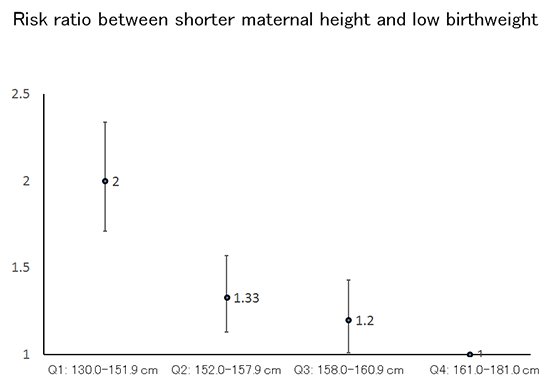1. Jananthan R, Wijesinghe DG, Sivananthewerl T. Maternal anthropometry as a predictor of birth weight. Trop Agric Res. 2009; 21:89–98.
2. Kramer MS. The epidemiology of adverse pregnancy outcomes: an overview. J Nutr. 2003; 133:1592S–15926S.
3. Ozaltin E, Hill K, Subramanian SV. Association of maternal stature with offspring mortality, underweight, and stunting in low- to middle-income countries. JAMA. 2010; 303:1507–1516.
4. Wills AK, Chinchwadkar MC, Joglekar CV, Natekar AS, Yajnik CS, Fall CH, Kinare AS. Maternal and paternal height and BMI and patterns of fetal growth: the Pune Maternal Nutrition Study. Early Hum Dev. 2010; 86:535–540.
5. Witter FR, Luke B. The effect of maternal height on birth weight and birth length. Early Hum Dev. 1991; 25:181–186.
7. Organisation for Economic Co-operation and Development. Trends in low birth weight infants, selected OECD countries, 1980-2007. Health at a Glance 2009: OECD Indicators. Paris: OECD Publishing;2009. p. 33.
8. Inoue S, Naruse H, Yorifuji T, Murakoshi T, Doi H, Kawachi I. Who is at risk of inadequate weight gain during pregnancy? Analysis by occupational status among 15,020 deliveries in a regional hospital in Japan. Matern Child Health J. 2013; 17:1888–1897.
9. Takimoto H, Sugiyama T, Fukuoka H, Kato N, Yoshiike N. Maternal weight gain ranges for optimal fetal growth in Japanese women. Int J Gynaecol Obstet. 2006; 92:272–278.
10. Tsukamoto H, Fukuoka H, Inoue K, Koyasu M, Nagai Y, Takimoto H. Restricting weight gain during pregnancy in Japan: a controversial factor in reducing perinatal complications. Eur J Obstet Gynecol Reprod Biol. 2007; 133:53–59.
11. Subramanian SV, Ackerson LK, Davey Smith G, John NA. Association of maternal height with child mortality, anthropometric failure, and anemia in India. JAMA. 2009; 301:1691–1701.
12. Kashima S, Naruse H, Yorifuji T, Ohki S, Murakoshi T, Takao S, Tsuda T, Doi H. Residential proximity to heavy traffic and birth weight in Shizuoka, Japan. Environ Res. 2011; 111:377–387.
13. Yorifuji T, Naruse H, Kashima S, Murakoshi T, Kato T, Inoue S, Doi H, Kawachi I. Trends of preterm birth and low birth weight in Japan: a one hospital-based study. BMC Pregnancy Childbirth. 2012; 12:162.
14. Yorifuji T, Naruse H, Kashima S, Murakoshi T, Tsuda T, Doi H, Kawachi I. Residential proximity to major roads and placenta/birth weight ratio. Sci Total Environ. 2012; 414:98–102.
15. Wilcox AJ. On the importance--and the unimportance--of birthweight. Int J Epidemiol. 2001; 30:1233–1241.
16. Mikami S, Hamano T, Fujii N, Nagasawa Y, Isaka Y, Moriyama T, Matsuhisa M, Ito T, Imai E, Hori M. Serum osteoprotegerin as a screening tool for coronary artery calcification score in diabetic pre-dialysis patients. Hypertens Res. 2008; 31:1163–1170.
17. Subramanian SV, Özaltin E, Finlay JE. Height of nations: a socioeconomic analysis of cohort differences and patterns among women in 54 low- to middle-income countries. PLoS One. 2011; 6:e18962.
18. Maternal anthropometry and pregnancy outcomes. A WHO Collaborative Study. Bull World Health Organ. 1995; 73:Suppl. 1–98.
19. Zhang X, Cnattingius S, Platt RW, Joseph KS, Kramer MS. Are babies born to short, primiparous, or thin mothers "normally" or "abnormally" small? J Pediatr. 2007; 150:603–607.








 PDF
PDF ePub
ePub Citation
Citation Print
Print





 XML Download
XML Download